Safari in the Red Desert of Namibia
July 17, 2024
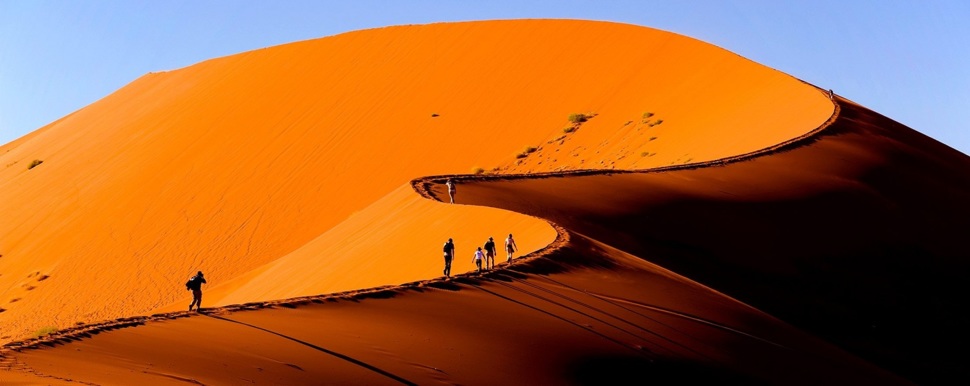
A white sun over yellow sands – this is the common idea of Africa. The distant and unknown continent is full of not only stereotypes, but also mysteries for us. It is not made up entirely of deserts, and deserts are not made up entirely of sand. The vast expanses can be flooded by sudden streams of water. And the hot and harsh climate does not scare away hundreds of species of birds and animals.
But of all the mysteries of Africa, one is the hardest to solve. How did a red desert with a Martian appearance appear in the middle of quite earthly landscapes? And why do not only dunes several hundred meters high grow in it, but also canyons with cliffs? We set off in search of answers to a unique country, Namibia.
Namibia - Why go there?
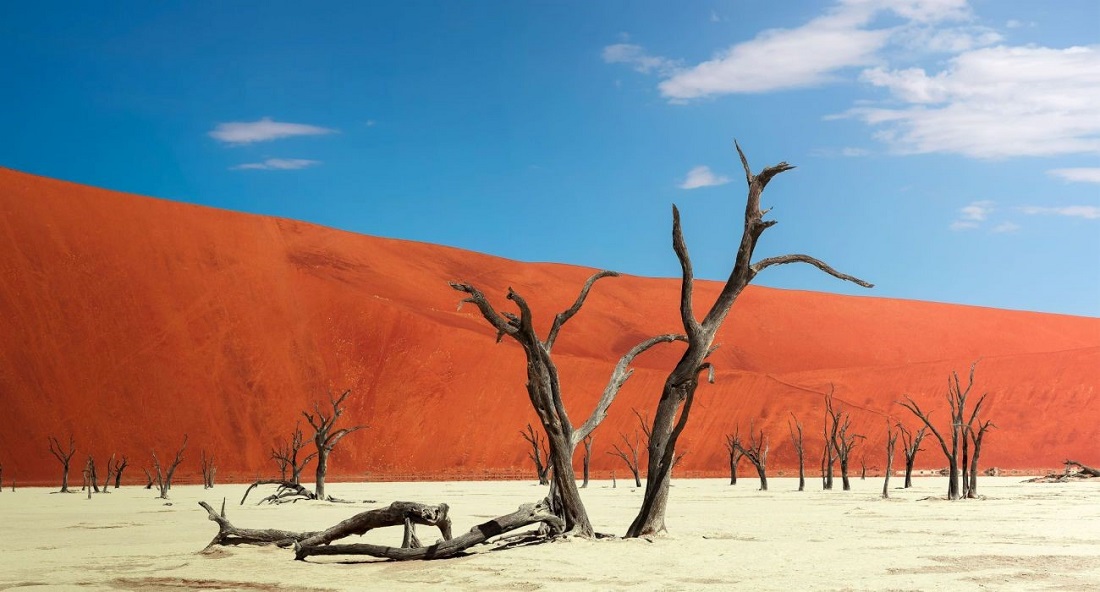
The Red Sands are Namibia's premier tourist attraction. But they are far from the only one.
Namibia is a young and therefore little-known country. However, it would be wrong to assume that the country's authorities do not care about the development of tourism. Yes, a third of Namibia's income comes from underground wealth, diamonds. But the government is not inclined to ignore the treasure that will not run out like minerals - tourists.
And yet, the skepticism of a traveler who glances at a geographical map is sure to manifest itself. How could it be otherwise - a significant part of the country's territory is occupied by deserts. But Namibia treats deserts not as lifeless and useless land, but as its nurse. Dozens of tourist routes have been laid along them, opening up extraordinary landscapes to the eyes of the brave and forever changing the idea of deserts.
Traveling to a harsh climate zone can be not only a walking or driving challenge, a test of strength, but also give unexpected encounters with desert elephants, rare bird species and amazing plants. The best time to travel to Namibia is from May to October. Then the heat will not bother you so much.
The two most famous desert regions of the state are Namib and Kalahari. The first is considered the oldest desert in the world. The sands that make it up have known the heavy footsteps of dinosaurs, they are already about 80 million years old! Now tourists rush along them in search of the legendary red dunes.
Visa to Namibia
Traveling to Namibia only seems difficult to organize. In fact, the country is very loyal to tourists and awaits them with open arms - diamonds are not the only way to fill the budget.
Therefore, the state has established simplified visa rules for visitors. Belarusians do not need to apply for a Namibian visa if your trip does not last longer than 90 days. Do not forget to take a tourist voucher or hotel reservations, as well as a return ticket. They will be needed for unhindered entry.
Tickets to Namibia
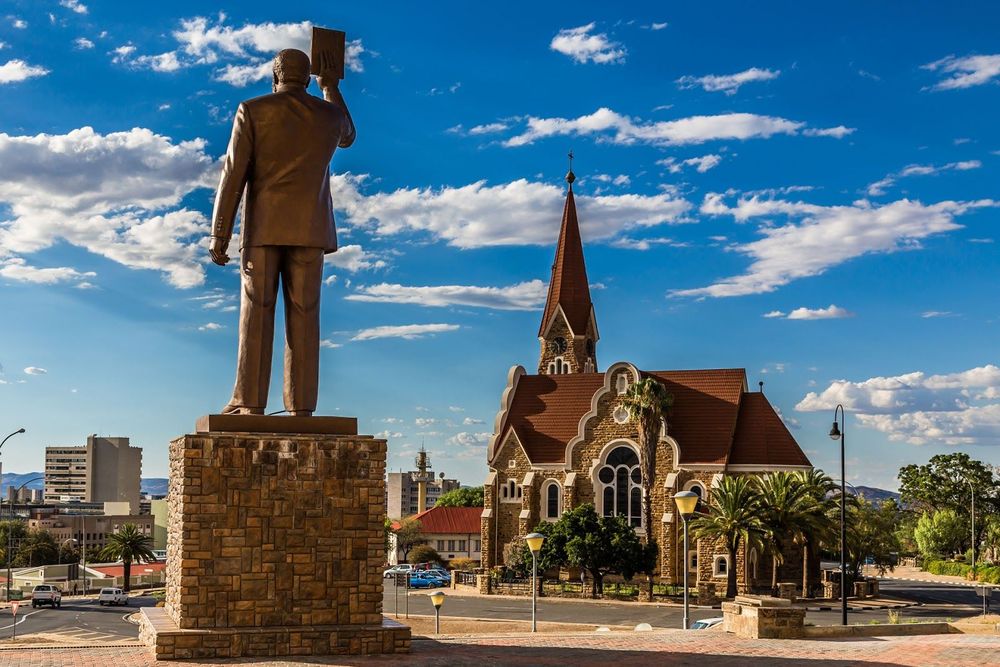
Getting to know Namibia will begin with the capital, Windhoek. Photo Rough Guides
The route to the distant country is not so difficult either. A direct air route is laid from Frankfurt am Main. Lufthansa operates regular flights from the main German airport. Ticket prices in season start from $1,000 for a round-trip package. By the way, the German flagship airline is in the top 20 of the rating the safest airlines in the world .
You can search for air tickets to Namibia using the convenient online platform Travel Code.
Accommodation
Travelers who imagine Africa as a kind of "third world" will be pleasantly surprised by the service provided on site. The capital of Namibia, Windhoek, appears to be a modest but modern city with good hotels and a calm, measured life.
Most organized excursions start and end here. If you choose local safari tours , accommodation will be taken care of for you in themed lodges and campsites. Specialized safari lodges in Namibia will provide the best immersion into the atmosphere of wild nature.
For those who like to organize their leisure time independently, booking hotels in Namibia of different comfort categories is also available. Even in the desert you can find a cozy place.
Getting Around Namibia
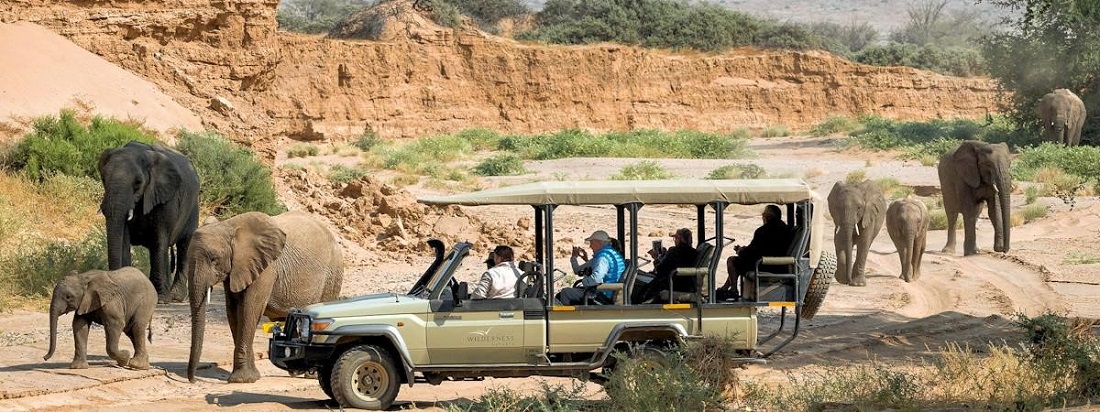
An SUV in Namibia is a guarantee of a bright holiday, and sometimes survival. Photo Uyaphi.com
Whatever direction in Namibia you choose, you will need a reliable iron companion. The distances are large, and moving through the desert is completely unthinkable without an SUV. The ideal option would be to purchase a tour of Namibia in advance . Then you will be picked up from the airport, shown the capital, driven to the lions, elephants and leopards, so much so that the red dust from under the wheels of the car will eclipse the horizon.
An alternative option would be to rent a transfer in Namibia to the locations you are interested in. Or rent a car from local rental companies. If you choose to go on a safari in Namibia on your own by car, Consider only 4x4 SUV rentals. Otherwise, you risk getting stuck in the desert or limiting yourself to traveling on good but boring Namibian highways.
When planning your own safari holiday in Namibia, the best route is to travel from Windhoek along one of two routes. The first is to the north, to Etosha National Park and then northwest, to the “Skeleton Coast”, which is frightening in its very name. The second route will take you towards the Lüderitz Peninsula with a mandatory stop in the Namib-Naukluft National Park. If the sandy landscapes do not let you go, head further southeast, to the Kalahari and Kgalagadi Transfrontier Park .
Namib-Naukluft
All preparations are done - you can hit the road and storm the dunes! For them, yellow, white and red, you need to go to the fourth largest national park in the world, Namib-Naukluft.
Sesriem
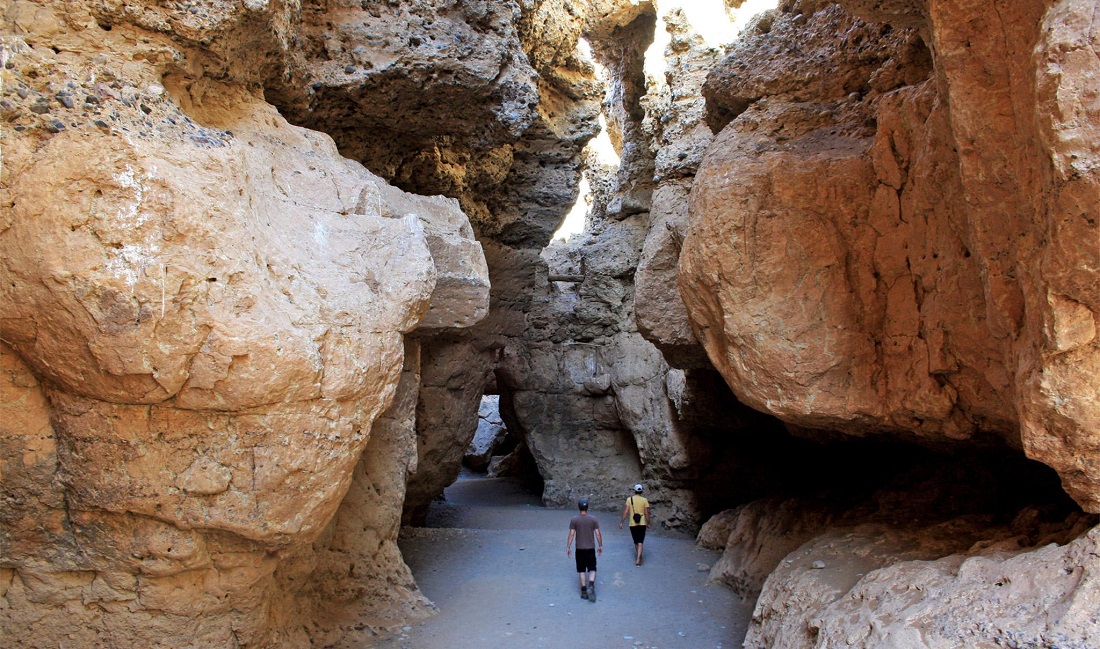
Sesriem Canyon. Photo by Namibia Experience
At first, the desert will appear to us in an unexpected form. Instead of sand, there are rocks, reminiscent of Indiana Jones's path to the Holy Grail's refuge in the city of Alexandretta. The Jordanian Petra became the backdrop for the world-famous film . Its entrance, called the Siq Canyon, is very reminiscent of its Namibian counterpart, the Sesriem Canyon .
Sesriem is a kilometer-long gorge, the walls of which rise 30 meters into the air. The fact that the human settlement near Sesriem is extremely modest - just a gas station, a couple of kiosks and houses - contributes to the complete immersion in wild nature. But nature skillfully compensates for the asceticism of human architecture.
Dune 45
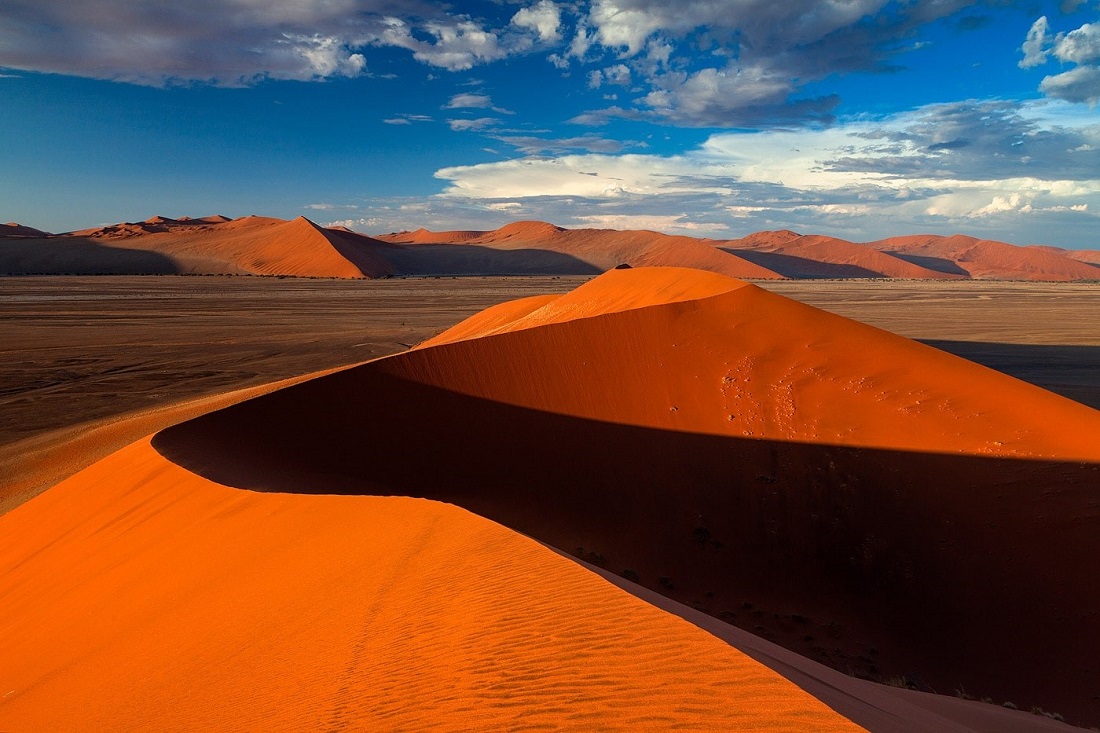
Dunes: Namibia's Natural Skyscrapers. Photo Shutterstock
Guidebooks recommend meeting the sunrise or sunset at the first sand skyscraper, 45 kilometers from Sesriem. It is worth checking the laudatory reviews and planning your arrival at Dune 45 at the right time. Or better yet, in advance, to take a closer look at the dune itself. The 80-meter natural structure is worthy of being not only an observation deck, but also a geological museum. Its sands are more than five million years old!
Sossusvlei
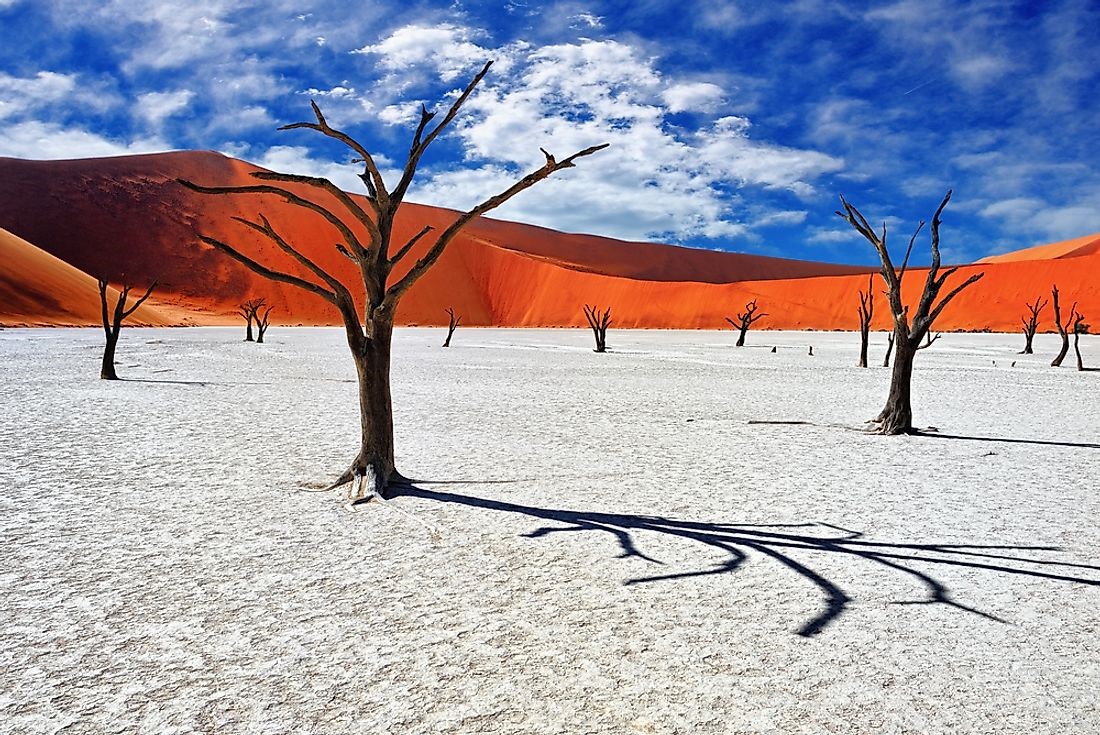
The Sossusvlei Valley is a mix of red, black, white and yellow. Photo World Atlas
66 kilometers of sandy landscapes, dunes and sand dunes that eclipse the sun - and we are at the main point of the route - Sossusvlei. This clay cauldron created the legend of the red desert.
The red color of the local sands is not due to clay, but to iron. Oxidized by the air, it creates the impression that the sand is rusty. The older the dune, the redder the color of its sand. Here is the answer to Namibia's Martian puzzle.
In pursuit of red sand, tourists for some reason ignore another natural anomaly. The bottom of the pit, unlike the surrounding dunes, is white. This time, the palette is intervened by salt deposits covering the surface of Sossusvlei.
But an even more unexpected guest in the pit is not salt or iron, but water. One of the driest places on earth sometimes becomes a place of... flood. The Tsauchab River now and then gets a stream of moisture from the sky. And carries its waters into the trap. The riverbed blocked by dunes is interrupted here, and Sossuslvey at such moments becomes a quagmire. This is announced by the very name of the location - "dead-end swamp".
"Big Daddy" and "Big Momma"
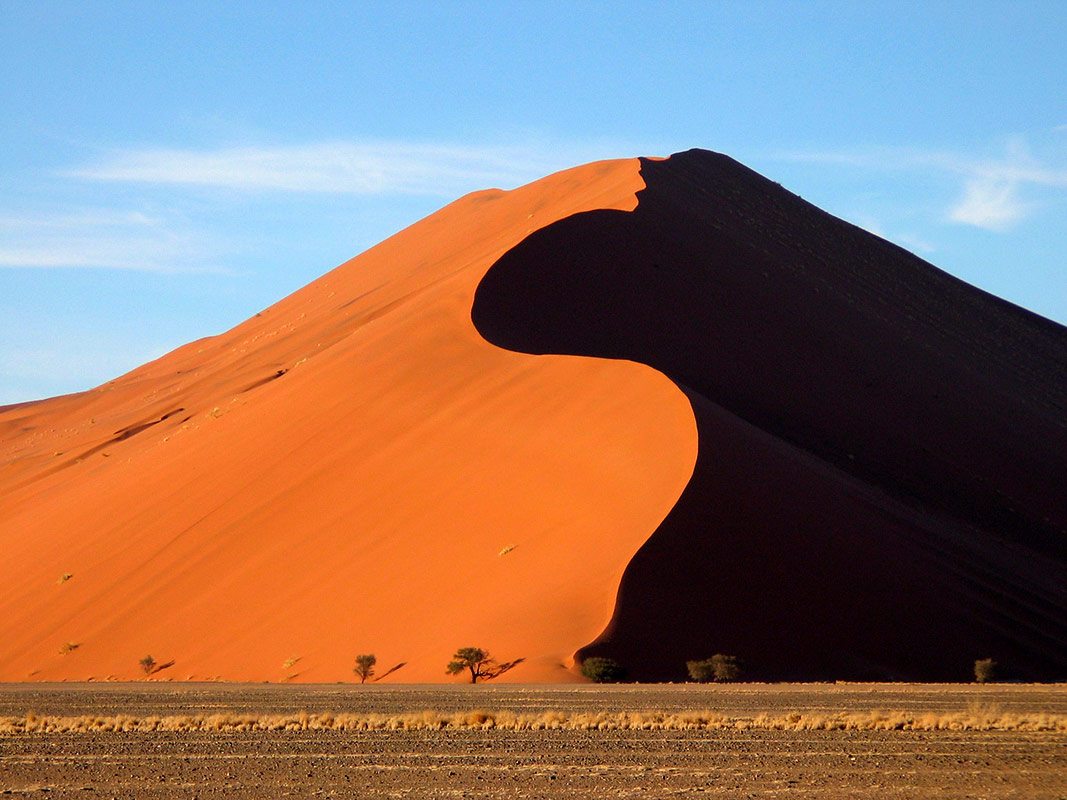
The Namib-Naukluft Park is not only interesting for its red sand, but also for its largest dunes in Namibia. Photo by Art of Safari
What kind of family is this, settled in the middle of the desert, you ask. We answer: respectable, old and proud. Despite the funny names, two huge dunes will wipe the smile off the traveler's face while he climbs them.
"Big Daddy" is the tallest dune in Sossusvlei. It reaches 325 meters in height. Over thousands of years, the wind has been shaping the magnificent skyscraper of the Namib Desert. And such skyscrapers form an entire "block" called "Star Dune".
As is customary in the family, the wife does not let her handsome husband go far. The Big Mama dune is located just a few kilometers from the sand giant. It rises 200 meters and is suitable for conquering for those who are not confident in their ability to storm the neighboring peak.
Safari tours in Namib-Naukluft
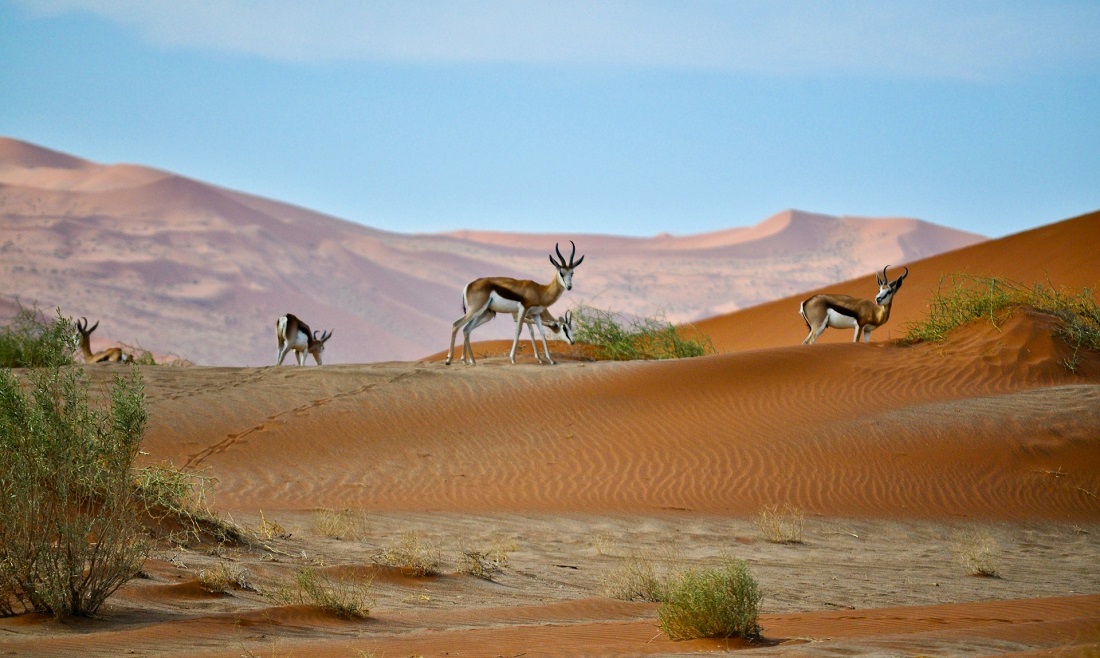
In the desert, antelopes, ostriches and gazelles will be the objects of the safari. And in Etosha, you can meet all of Africa's Big Five. Photo by Unsplash
Safari in Africa attracts millions of tourists every year. And today, to have a successful trip, you don’t need to have hunting skills, you just need to know how to use a camera!
In Namibia, photo hunting has a huge number of suitable locations and options. In the Namib-Naukluft Park and the red desert, the most suitable will be an air safari. Having risen in a hot air balloon, you will finally be able to haughtily look at the dunes, with which you will be on equal terms. You will see the desert from a rare angle and catch the first rays of the rising sun.
Another popular safari tour is birdwatching. In Namib-Naukluft, or rather above it, there are 370 species of birds. Among them are rare specimens of the fauna world - the dune lark, the pale-winged starling, the light songhawk, the Hartlaub francolin and others. You can notice the desired objects of photo hunting in advance from the list .
The desert country is home to the "African Big Five" - lion, elephant, leopard, rhino and buffalo. The perfect safari in Namibia can be considered if you photograph the entire “elite club”. But in the Namib-Naukluft Park you will not see the “big five” in full force. It is better to postpone the pursuit of them until a visit to the Etosha National Park in the north. During a desert safari, several species of antelope, jackals, hyenas and bat-eared foxes may appear in the photos.
The Welwitschia tree will complement the amazing picture of the desert's wildlife. The plant is so unusual and original that it has the honor of being present on the national coat of arms of Namibia. It is easy to mistake Welwitschia for a bush that has spread out to the sides. For some reason, it prefers to grow in width, reaching a diameter of four meters with a height of one. And Welwitschia also challenges sequoias in a competition of longevity. The age of the oldest Welwitschia reaches two thousand years.
Kalahari
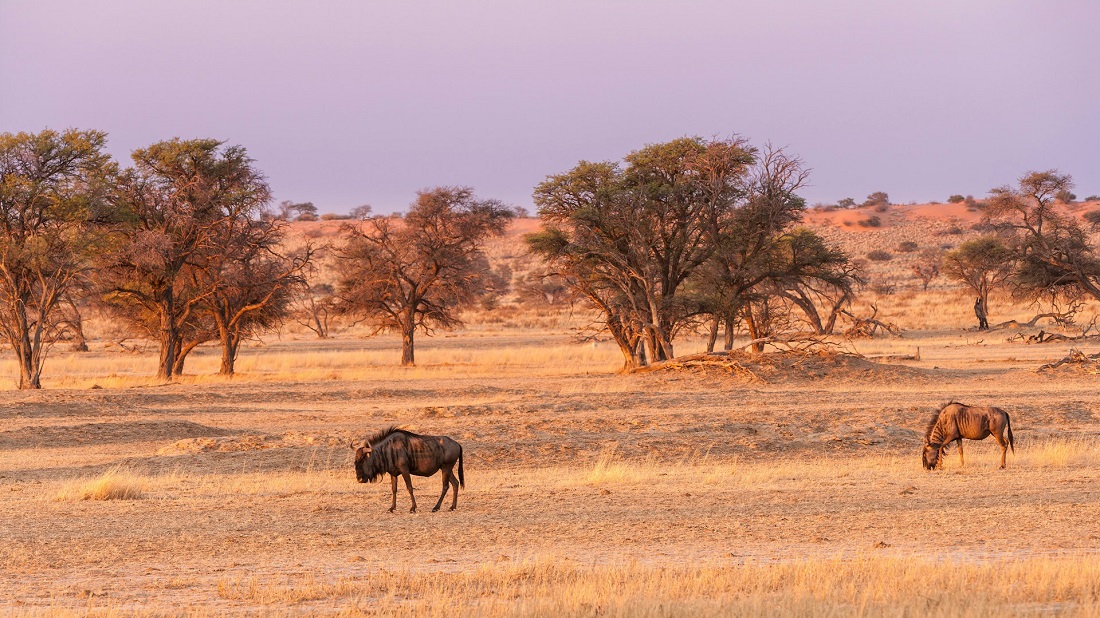
The Kalahari is not exactly a desert. It is a sand savannah.
The Namib Desert and Sossusvlei have firmly occupied the popular status of the red desert in tourist guides. However, to the great joy of tourists, there is not only one red desert in Namibia. The color of passion and vice can also be seen in the Kalahari Desert in the southeast of the country. It is shared between the Republic of South Africa and Namibia.
Strictly speaking, the Kalahari is not a desert. Despite its name (in the Kala language it means "great thirst" and in the Tswana language "waterless place"), the region receives an unacceptably large amount of precipitation for a self-respecting desert - up to 500 mm per year. For comparison, the Namib Desert receives only 10-13 mm. That is why demanding geographers call the Kalahari a sandy savanna.
If, amidst all the animal and plant diversity of the Kalahari, you are still drawn to the red sands, you will not be disappointed. You will find red dunes all over the savannah. Special 4x4 excursions are organized to hunt for them.
Kgalagadi
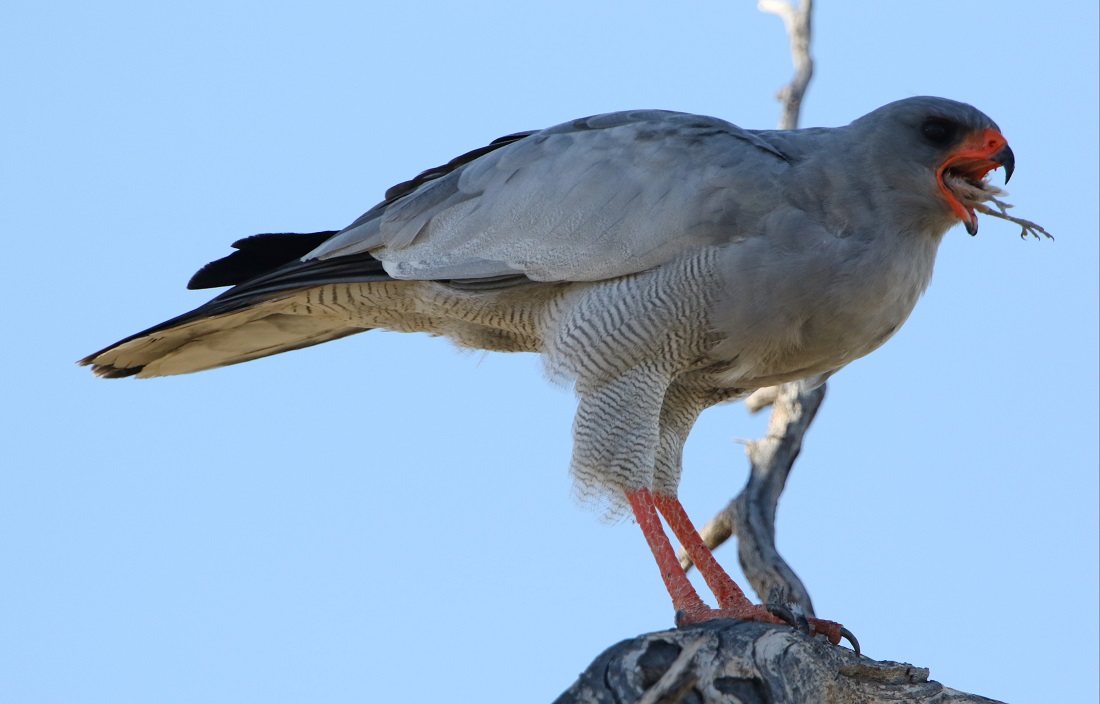
The light-winged hawk is one of the tempting specimens for photo hunting.
One of the tours even allows you to open an additional country on your travel map — Botswana. The Kgalagadi Transfrontier Park, famous for its red sandy terrain, adjoins the Kalahari from the east. The lifeless views of the red dunes here will once again be challenged by a rich biosphere — the reserve is considered no less than a stronghold of the lions of South Africa. The local huge cats have a remarkable feature — black manes. And here you will also encounter rare caracals, African wild cats, wildebeests and giraffes. Just keep clicking your camera!
A reasonable question may arise: since Kgalagadi is located in neighboring countries, will Belarusians need to apply for visas to South Africa or Botswana? A pleasant surprise! Kgalagadi is called a "peace park" - not only animals scurrying between countries know no borders here, but people do too. Provided that you enter and exit the park through Namibia, there is no need to apply for visas.
You won't have to say goodbye to the beautiful wild nature even when you get tired of walking. On the Namibian side, there are campsites, lodges and guest farms. Before going to bed, you will enjoy the unique landscapes of the southern sky under the measured crackling of a fire.
Kalahari Safari Tours
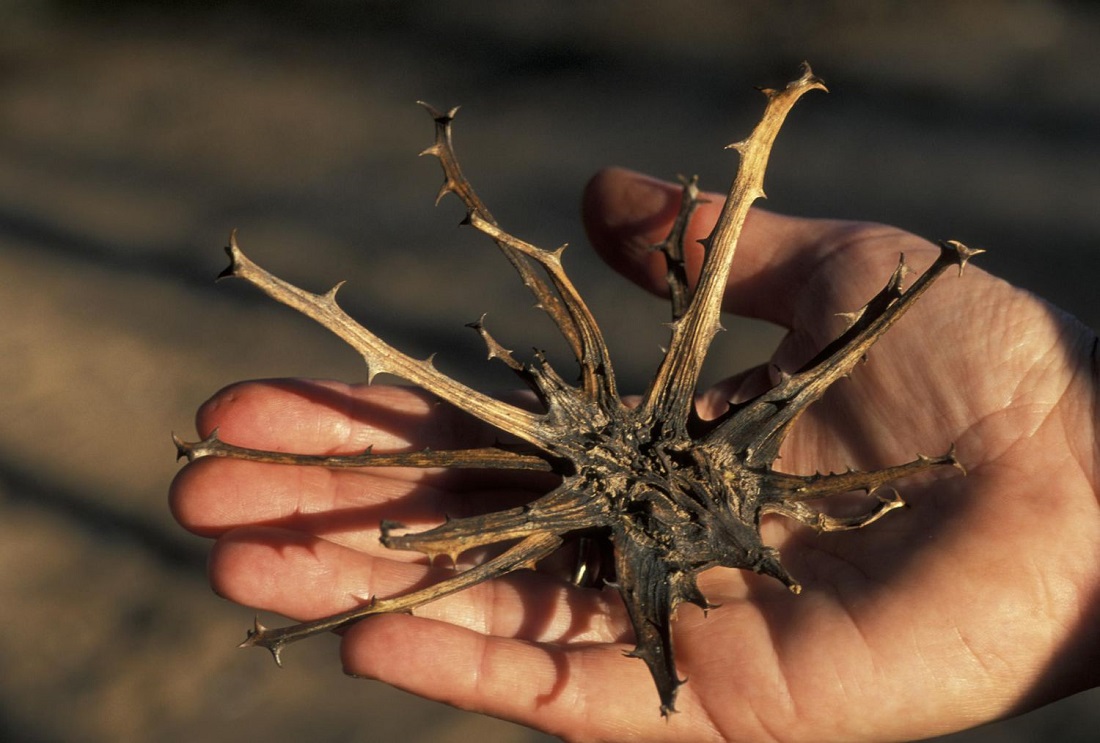
An unsightly plant from Namibia, Devil's Claw has a lot of medicinal uses. Photo by Verywell Health
But for a successful photo hunt, it is not necessary to go to a neighboring country. The best safari tours of Namibia can be organized in the Kalahari itself. Thanks to the milder climate, dozens of species of mammals have chosen the region as their home. You have a good chance of meeting not only leopards, antelopes, hyenas and ostriches, but also fast-footed cheetahs and the king of beasts, the lion.
There are also 300 species of birds in the Kalahari. Among them is the amazing social weaver. Its strange name fully reflects the "active civic position" of the bird. These weavers build the largest nests in the world, capable of accommodating up to 500 individuals. And such dormitories weigh up to a ton! Invitations to settle there are only given to birds, they do not like strangers. Therefore, to search for unique nests, it is better to use the services of special guides.
Among all the diversity of the animal world, do not forget the plant world - a unique plant with a frightening name "devil's claw" grows in the region. It got its name for its unusually shaped fruits. Despite its unflattering name and such an unpleasant appearance, "devil's claw" is actively used in medicine. It is believed that it helps to cope with back pain and arthritis.
Bushmen settlements
In addition to lions, cheetahs and antelopes, the Bushmen rightfully call the Kalahari their home. They claim to have lived in this area for 20,000 years, without changing their traditional occupations, hunting and gathering. Despite the innovations that have reached them, many Bushmen are still faithful to the technologies of their ancestors. As part of special tours, they are willing to share their customs, culture and wisdom with tourists. Traveling through the Kalahari, you can get an idea of these remarkable people and learn not only about their traditions, but also about the life of the Bushmen in the modern world.
Discover the enchanting red deserts of Namibia, incredible safari tours and a sea of new impressions with your guide to the world of exotic tours, Travel Code !
We send only top, fresh and useful info.
Subscribe and be the first to know!


 USD - $
USD - $  EUR - €
EUR - € 











